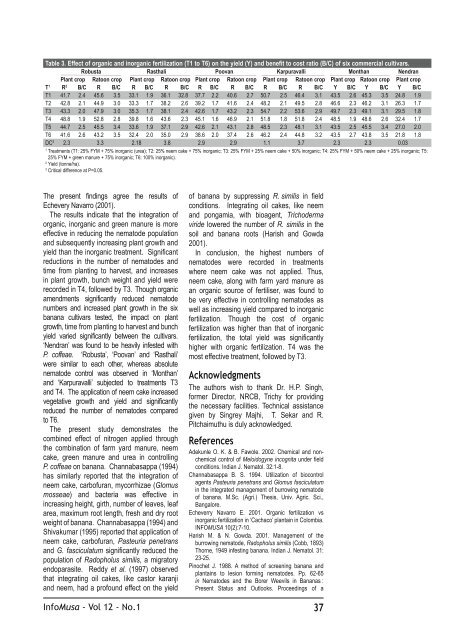Château-Musa - Bioversity International
Château-Musa - Bioversity International
Château-Musa - Bioversity International
You also want an ePaper? Increase the reach of your titles
YUMPU automatically turns print PDFs into web optimized ePapers that Google loves.
Table 3. Effect of organic and inorganic fertilization (T1 to T6) on the yield (Y) and benefit to cost ratio (B/C) of six commercial cultivars.<br />
Robusta Rasthali Poovan Karpuravalli Monthan Nendran<br />
Plant crop Ratoon crop Plant crop Ratoon crop Plant crop Ratoon crop Plant crop Ratoon crop Plant crop Ratoon crop Plant crop<br />
T 1 R 2 B/C R B/C R B/C R B/C R B/C R B/C R B/C R B/C Y B/C Y B/C Y B/C<br />
T1 41.7 2.4 45.6 3.5 33.1 1.9 36.1 32.8 37.7 2.2 40.6 2.7 50.7 2.5 46.4 3.1 43.5 2.6 45.3 3.5 24.8 1.9<br />
T2 42.8 2.1 44.9 3.0 33.3 1.7 38.2 2.6 39.2 1.7 41.6 2.4 48.2 2.1 49.5 2.8 46.6 2.3 46.2 3.1 26.3 1.7<br />
T3 43.3 2.0 47.9 3.0 35.3 1.7 38.1 2.4 42.6 1.7 43.2 2.3 54.7 2.2 53.6 2.9 49.7 2.3 49.1 3.1 29.5 1.8<br />
T4 48.8 1.9 52.8 2.8 39.8 1.6 43.6 2.3 45.1 1.6 46.9 2.1 51.8 1.8 51.8 2.4 48.5 1.9 48.6 2.6 32.4 1.7<br />
T5 44.7 2.5 45.5 3.4 33.6 1.9 37.1 2.9 42.6 2.1 43.1 2.8 48.5 2.3 48.1 3.1 43.5 2.5 45.5 3.4 27.0 2.0<br />
T6 41.6 2.6 43.2 3.5 32.4 2.0 35.0 2.9 38.6 2.0 37.4 2.6 46.2 2.4 44.8 3.2 43.5 2.7 43.8 3.5 21.8 1.8<br />
DC 3 2.3 3.3 2.18 3.8 2.9 2.9 1.1 3.7 2.3 2.3 0.03<br />
1 Treatments (T1: 25% FYM + 75% inorganic (urea); T2: 25% neem cake + 75% inorganic; T3: 25% FYM + 25% neem cake + 50% inorganic; T4: 25% FYM + 50% neem cake + 25% inorganic; T5:<br />
25% FYM + green manure + 75% inorganic; T6: 100% inorganic).<br />
2 Yield (tonne/ha).<br />
3 Critical difference at P=0.05.<br />
The present findings agree the results of<br />
Echevery Navarro (2001).<br />
The results indicate that the integration of<br />
organic, inorganic and green manure is more<br />
effective in reducing the nematode population<br />
and subsequently increasing plant growth and<br />
yield than the inorganic treatment. Significant<br />
reductions in the number of nematodes and<br />
time from planting to harvest, and increases<br />
in plant growth, bunch weight and yield were<br />
recorded in T4, followed by T3. Though organic<br />
amendments significantly reduced nematode<br />
numbers and increased plant growth in the six<br />
banana cultivars tested, the impact on plant<br />
growth, time from planting to harvest and bunch<br />
yield varied significantly between the cultivars.<br />
‘Nendran’ was found to be heavily infested with<br />
P. coffeae. ‘Robusta’, ‘Poovan’ and ‘Rasthali’<br />
were similar to each other, whereas absolute<br />
nematode control was observed in ‘Monthan’<br />
and ‘Karpuravalli’ subjected to treatments T3<br />
and T4. The application of neem cake increased<br />
vegetative growth and yield and significantly<br />
reduced the number of nematodes compared<br />
to T6.<br />
The present study demonstrates the<br />
combined effect of nitrogen applied through<br />
the combination of farm yard manure, neem<br />
cake, green manure and urea in controlling<br />
P. coffeae on banana. Channabasappa (1994)<br />
has similarly reported that the integration of<br />
neem cake, carbofuran, mycorrhizae (Glomus<br />
mosseae) and bacteria was effective in<br />
increasing height, girth, number of leaves, leaf<br />
area, maximum root length, fresh and dry root<br />
weight of banana. Channabasappa (1994) and<br />
Shivakumar (1995) reported that application of<br />
neem cake, carbofuran, Pasteuria penetrans<br />
and G. fasciculatum significantly reduced the<br />
population of Radopholus similis, a migratory<br />
endoparasite. Reddy et al. (1997) observed<br />
that integrating oil cakes, like castor karanji<br />
and neem, had a profound effect on the yield<br />
of banana by suppressing R. similis in field<br />
conditions. Integrating oil cakes, like neem<br />
and pongamia, with bioagent, Trichoderma<br />
viride lowered the number of R. similis in the<br />
soil and banana roots (Harish and Gowda<br />
2001).<br />
In conclusion, the highest numbers of<br />
nematodes were recorded in treatments<br />
where neem cake was not applied. Thus,<br />
neem cake, along with farm yard manure as<br />
an organic source of fertiliser, was found to<br />
be very effective in controlling nematodes as<br />
well as increasing yield compared to inorganic<br />
fertilization. Though the cost of organic<br />
fertilization was higher than that of inorganic<br />
fertilization, the total yield was significantly<br />
higher with organic fertilization. T4 was the<br />
most effective treatment, followed by T3.<br />
Acknowledgments<br />
The authors wish to thank Dr. H.P. Singh,<br />
former Director, NRCB, Trichy for providing<br />
the necessary facilities. Technical assistance<br />
given by Singrey Majhi, T. Sekar and R.<br />
Pitchaimuthu is duly acknowledged.<br />
References<br />
Adekunle O. K. & B. Fawole. 2002. Chemical and nonchemical<br />
control of Meloidogyne incognita under field<br />
conditions. Indian J. Nematol. 32:1-8.<br />
Channabasappa B. S. 1994. Utilization of biocontrol<br />
agents Pasteuria penetrans and Glomus fasciculatum<br />
in the integrated management of burrowing nematode<br />
of banana. M.Sc. (Agri.) Thesis, Univ. Agric. Sci.,<br />
Bangalore.<br />
Echeverry Navarro E. 2001. Organic fertilization vs<br />
inorganic fertilization in ‘Cachaco’ plantain in Colombia.<br />
INFOMUSA 10(2):7-10.<br />
Harish M. & N. Gowda. 2001. Management of the<br />
burrowing nematode, Radopholus similis (Cobb, 1893)<br />
Thorne, 1949 infesting banana. Indian J. Nematol. 31:<br />
23-25.<br />
Pinochet J. 1988. A method of screening banana and<br />
plantains to lesion forming nematodes. Pp. 62-65<br />
in Nematodes and the Borer Weevils in Bananas :<br />
Present Status and Outlooks. Proceedings of a<br />
Info<strong>Musa</strong> - Vol 12 - No.1 37

















